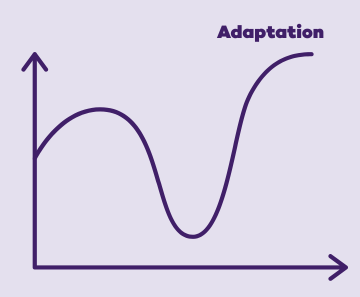Cultural Adjustment
The Journey
It is commonly acknowledged that there are four stages of cultural adjustment, but this process is not always linear. You may find yourself moving back and forth between stages as you encounter new experiences, challenges, and personal growth. Understanding these phases can help you navigate the emotional and psychological shifts that come with living abroad.
Honeymoon Stage
- Initial excitement about new surroundings
- Tourist-like involvement in the host culture
- High motivation to learn and engage
- Interest in cultural similarities and differences
Culture Shock Stage
- Focus shifts to differences between home and host cultures
- Small issues feel like major challenges
- Homesickness and frustration may emerge
- Might find yourself criticizing local practices
Gradual Adjustment Stage
- Increased understanding of local cultural logic and values
- Return of humor and perspective
- Recognition of preferred aspects in both cultures
- Deeper questioning of global assumptions
Adaptation Stage
- Feeling at home in your host country
- Balanced appreciation of cultural differences
- Ability to live and work to your full potential
- Integration into local community
Navigating Cultural Differences
It is natural to face challenges when adjusting to a new culture. When things get tough:
- Stop and Reflect - Ask yourself what your reaction reveals about your own cultural assumptions.
- Journal Your Experience - Writing can help you:
- Process your reactions
- Gain objectivity
- Understand cultural differences
- Track your adjustment progress
- Develop Practical Skills - Here are six strategies to build intercultural understanding, inspired by Slimbach’s framework:
- Cultivate curiosity and empathy—ask respectful questions and actively listen.
- Discover cultural conditioning—reflect on how your upbringing shapes your views.
- Recognize social variables—consider age, gender, or status in interactions.
- Identify situational contexts—notice what’s appropriate for the setting.
- Understand behavioral motivations—explore the values behind actions.
- Evaluate cultural generalizations—use patterns thoughtfully, not as rules.
Navigating cultural differences isn’t just about overcoming challenges; it’s about developing cultural intelligence, the ability to understand and adapt to diverse perspectives and practices. This skill is invaluable, both abroad and in your everyday life. It’s okay to feel overwhelmed or frustrated at times. These emotions are a natural part of the adjustment process and a sign that you’re growing. Sharing your experiences with others can help you process your journey and gain new insights. Remember, every challenge you face is an opportunity to build resilience, deepen connections, and thrive in your new cultural environment.
Cultural Exchange vs. Personal Boundaries
While cultural understanding is crucial, it doesn't mean accepting behavior that makes you unsafe or uncomfortable. If you experience harassment or feel unsafe:
- Trust your instincts
- Contact program staff
- Use available resources
- Document incidents
- Seek support
Resources and Tools
Cultural Resources
US Government Resources
Go Beyond
- Johnson, M. (2009). Post-reciprocity: In defense of the "post" perspective. Frontiers: The Interdisciplinary Journal of Study Abroad, 18, 181-186.
-
- Slimbach, R. (2005). The transcultural journey. Frontiers: The Interdisciplinary Journal of Study Abroad, 11, 205-230.
- Slimbach, R. (2012). Becoming world wise: A guide to global learning. Sterling, VA: Stylus Publishing.



